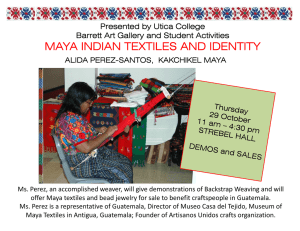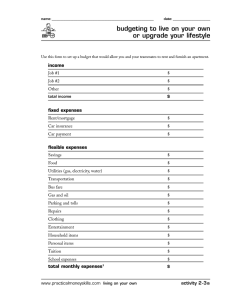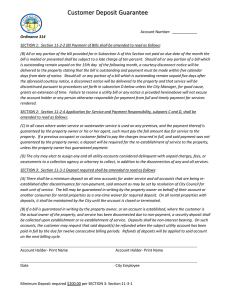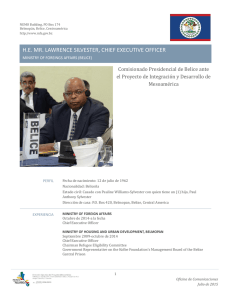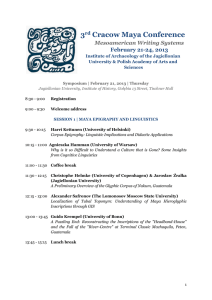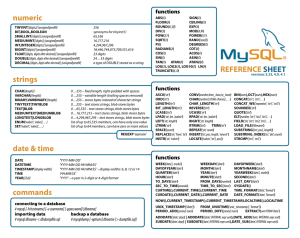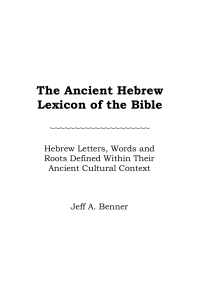Investigations of Middle Preclassic Public Architecture at the
Anuncio
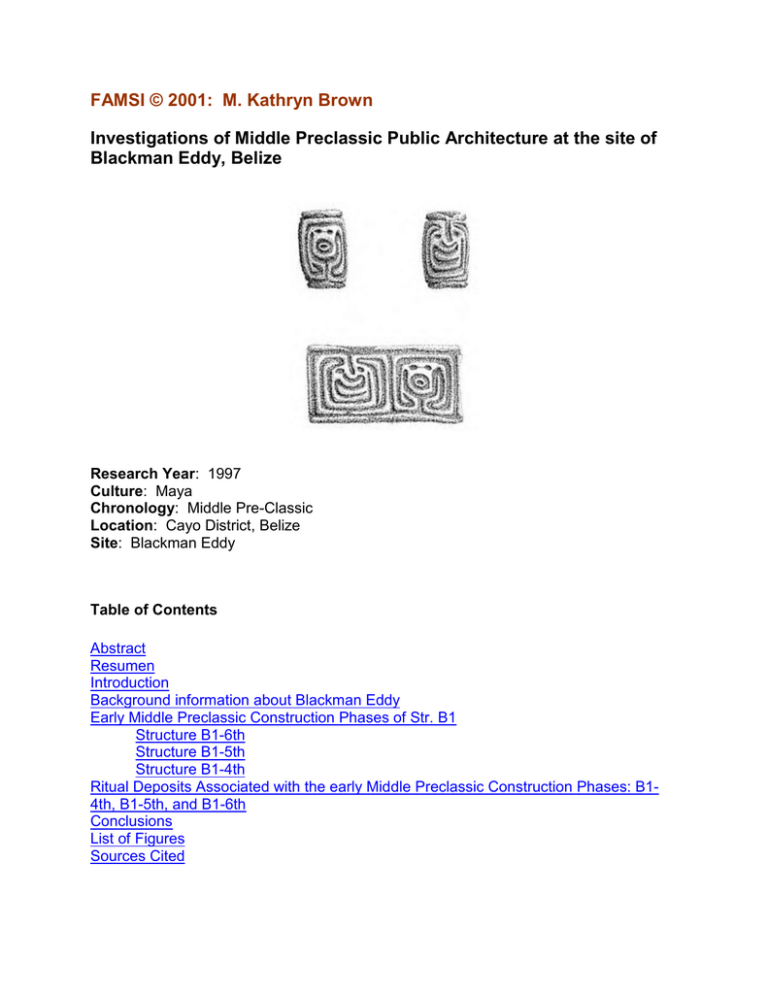
FAMSI © 2001: M. Kathryn Brown Investigations of Middle Preclassic Public Architecture at the site of Blackman Eddy, Belize Research Year: 1997 Culture: Maya Chronology: Middle Pre-Classic Location: Cayo District, Belize Site: Blackman Eddy Table of Contents Abstract Resumen Introduction Background information about Blackman Eddy Early Middle Preclassic Construction Phases of Str. B1 Structure B1-6th Structure B1-5th Structure B1-4th Ritual Deposits Associated with the early Middle Preclassic Construction Phases: B14th, B1-5th, and B1-6th Conclusions List of Figures Sources Cited Abstract This report will focus on Middle Preclassic public architecture from the site of Blackman Eddy, Belize. The Southwest Texas State University Belize Valley Archaeological Project began investigating the site of Blackman Eddy in the summer of 1990 and has continued to the present. In 1990, survey and test excavations were initiated in the site core of Blackman Eddy. The site of Blackman Eddy is located in Cayo District, Belize, approximately 200 meters south of the Western Highway on a hill overlooking Blackman Eddy village and the Belize River floodplain. Resumen El foco de este informe estará puesto en la estructura pública del Preclásico Medio del sitio de Blackman Eddy, en Belice. Con el Proyecto Arqueológico Valle de Belice de la Southwest Texas State University, en el verano de 1990 se comenzó a investigar el sitio de Blackman Eddy, y se ha continuado haciéndolo hasta el presente. En 1990 se iniciaron los relevamientos y las excavaciones de prueba en el núcleo del sitio de Blackman Eddy. El sitio de Blackman Eddy está ubicado en el Distrito del Cayo, en Belice, aproximadamente 200 metros al sur de la Autopista del Oeste y sobre una colina que mira hacia el pueblo de Blackman Eddy y a la planicie aluvional del Río Belice. Submitted 10/01/1998 by: M. Kathryn Brown [email protected] Introduction This report will focus on Middle Preclassic public architecture from the site of Blackman Eddy, Belize. Structure B1 at Blackman Eddy appears to have been the ritual focus of the site since the early Middle Preclassic. The numerous construction phases and additions indicate that the structure was in use for over 1500 years. The funding from FAMSI allowed for intensive investigation of the Middle Preclassic construction phases of the mound, as well as several carbon samples to be analyzed for chronological information. Horizontal exposure, and recording of a large portion of the two earliest construction phases was completed, as well as a preliminary analysis of the material culture recovered. The Middle Preclassic construction phases of Structure (Str.) B1 are unusual in several aspects. First, each construction phase dating to this time period is unique architecturally from the others. The architectural design of the building was 2 completely modified with each of the Middle Preclassic construction phases. Second, each Middle Preclassic construction phase is associated with extensive ritual deposits. Third, all three phases are architecturally larger and more elaborate than other typical structures dating to this time period, suggesting a public function for these early constructions. This report will also discuss in detail the ritual deposits found in association with these early construction phases. The ritual deposits appear to represent several types of ritual behavior, including dedication and termination rituals. Background information about Blackman Eddy The Southwest Texas State University Belize Valley Archaeological Project began investigating the site of Blackman Eddy in the summer of 1990 and has continued to the present. In 1990, survey and test excavations were initiated in the site core of Blackman Eddy. The site of Blackman Eddy is located in Cayo District, Belize, approximately 200 meters south of the Western Highway on a hill overlooking Blackman Eddy village and the Belize River floodplain. The site core of Blackman Eddy consists of two main plazas and a ballcourt (Figure 1). The largest plaza, Plaza A, includes several structures, two of which exceed the height of 10 meters. Attached to the southern end of Plaza A is a ballcourt. Plaza B is located at the northern portion of the site and has been severely damaged by unauthorized bulldozing activity. Evidence suggests that Plaza B is tightly enclosed with restricted access indicating a special function within the community. Str. B1 is the dominant architectural feature of Plaza B, rising to a height of over four meters from the modern plaza surface. Str. B1 is strategically placed on an elevated ridge allowing a commanding view of the Belize River and its alluvial plain. The bulldozing activity severely damaged Str. B1 by cutting and removing the entire western half of the mound. The resulting cut provided a complex profile of the central axis of the structure (Figure 2). This profile illustrates a construction history of five major construction phases, each with various revisions and additions. In 1994, the condition of Str. B1 was brought to the attention of the Belize Department of Archaeology. The department decided that the structure was too severely damaged to repair or stabilize. This decision prompted the initiation of a detailed salvage excavation program consisting of total horizontal exposure and recording of the intact construction phases to bedrock. 3 Figure 1. Blackman Eddy Site Core. During the 1991 field season limited test excavations were conducted on the summit of the structure revealing portions of the Str. B1-1st and Str. B1-2nd construction phases in addition to an elite burial on the medial axis. This Late Classic burial was accompanied by high status grave goods and is intrusive to Str. B1-2nd (Garber et al., 1992). During the 1992 and 1993 field seasons investigations continued on the summit revealing portions of Str. B1-1st, Str. B1-2nd, and Str. B1-3rd construction phases (Garber et al., 1993; 1994). 4 Figure 2. Bulldozer Cut Profile. Horizontal exposure of the southern face of Str. B1 was initiated in 1994 and continues to the present. During 1996 field season, architecture dating to the early Middle Preclassic was encountered. The 1997 field season, which was partially funded by the Foundation for the Advancement of Mesoamerican Studies, Inc. (FAMSI), focused on full horizontal exposure and recovery of material culture associated with the early Middle Preclassic construction phases of Str. B1 (B1-4th and B1-5th). The analysis of the cultural material recovered from B1-4th and B1-5th was initiated during the 1997 field season and continued through the 1998 field season, and is presently on going. Further investigations on the early construction phases of Str. B1 were conducted during the 1998 field season. Excavations in 1998 revealed an earlier construction phase, designated B1-6th, which was not evident from the analysis of the bulldozer cut profile. A brief summary of the later construction phases (B1-1st, B1-2nd, and B1-3rd) is provided for an understanding of the complete construction history of Structure B1, followed by a detailed description of the early construction phases (B1-4th, B1-5th, and B1-6th) and their associated ritual deposits. The terminal phase of Str. B1 dates to the Late Classic Period and was designated Str. B1-1st. This construction phase was heavily eroded and exact dimensions could not be defined. Str. B1-1st, however, appears to be a two tiered structure approximately 4.21 meters in height measured above the associated plaza surface. Seven partially preserved steps were recorded and it appears that several more steps were added during a rebuilding episode. The central staircase was outset 2.1 meters from the basal terrace of the structure. The construction technique employed consisted of well-trimmed coursed limestone masonry veneer approximately 20 by 20 by 10 cm in size (Garber et al., 1995). Str. B1-2nd was encountered directly beneath Str. B1-1st. This construction phase was well preserved and dates to the Protoclassic Period. Str. B1-2nd-b is a two tiered structure reaching a height of 3.32 m above its associated plaza surface and was adorned with painted stucco mask facades (Figure 3). The stucco masks were badly 5 damaged however traces of red paint were uncovered. Fortunately investigations revealed sufficient iconographic detail on the upper mask for an interpretation (Garber and Reilly, 1995) (Figure 4). The structure had a central outset staircase with seven steps leading to the summit. Excavations revealed an addition to the structure, Str. B12nd-a, which consisted of a series of three stepping platforms which were placed upon the summit of the structure. The addition raised the height of the structure to 3.92 m. A circular shaft, approximately 1.1 m in diameter, was cut through the summit of B1-2nd directly behind the upper tier mask, and was intrusive to all earlier construction phases. The shaft appears to be a large posthole which would have supported an enormous superstructure or scaffold. This vertical shaft is almost identical to the ones encountered on 5C-2nd at Cerros, Belize (David Freidel, personal communication, 1997). Figure 3. Reconstructed Isometric View of B1-2nd. 6 Figure 4. Drawing of upper mask (east of central staircase), Structure B1 at Blackman Eddy. Drawing by Jason Wiersema. The latest Middle Preclassic construction phase, Structure B1-3rd, had six additions to the original structure, of which four of these additions appear to date to the Late Preclassic time period (Figure 5). The earliest three sub-phases, B1-3rd-g, B1-3rd-f, and B1-3rd-e date to the late Middle Preclassic. The subsequent modifications doubled the height of the structure, and an outset staircase was added in B1-3rd-a. The earlier versions of the structure consisted of a large rectangular platform with an inset staircase. Flanking the staircase, the structure had outset platforms, which were constructed of large, cut limestone blocks. The summit of the original structure was heavily burned and may indicate desecratory termination activities at the site. Several of the later additions showed evidence of extensive burning as well. 7 Figure 5. Reconstructed Isometric View of B1-3rd. Early Middle Preclassic Construction Phases of Str. B1 Three construction phases have been encountered dating to the early Middle Preclassic time period, Str. B1-4th, Str. B1-5th, and Str. B1-6th. Each construction phase is quite unusual and is associated with elaborate ritual deposits. The investigation of the early structures at Blackman Eddy is a unique opportunity due to the excavation methodology employed on Str. B1. The large horizontal block excavations allowed for a detailed 8 examination of some of the earliest public architecture encountered in the Maya lowlands. In order for a clear understanding of the complex stratigraphy associated with the earliest architecture, the early Middle Preclassic construction phases of Str. B1 will be discussed in detail beginning with the earliest structure encountered to date. This will also allow for a better understanding of the construction techniques employed by the ancient Maya. Structure B1-6th As was stated above, Str. B1-6th was encountered during the 1998 field season. A small section of the front wall and summit surface was exposed. Excavation revealed that prior to its construction, ground surface was cleaned and a portion of bedrock was leveled. It is not known if earlier domestic or non-domestic remains were removed in this process. This cleaning and leveling process has been observed at other sites as well, and may indicate ritual purification of the location (Brown, 1995; Garber et al., n.d.). Present data suggests that Str. B1-6th is a single tiered platform approximately .45 m in height. Although the platform is relatively low, it appears to be quite expansive. The basal tread of the sustaining wall consisted of a single course of limestone masonry. Unfortunately the other courses were removed in antiquity. The summit surface was finished with a thick lime plaster. Evidence of a superstructure was not encountered, however the excavation area was limited and postholes may be located with further exposure of the summit. Intensive investigation of this structure is planned for the 1999 field season. The initial evidence from Str. B1-6th, however, suggests that this structure is larger and more finely constructed than other structures dating to the early Middle Preclassic possibly indicating a public function. An elaborate ritual deposit was encountered and appears to be associated with this construction phase. The deposit, discussed in detail below, consisted of a basin shaped depression cut into bedrock and layered with freshwater shells. Structure B1-5th Str. B1-5th was constructed directly on top of Str. B1-6th. Due to its size, complexity, and associated ritual deposits, Str. B1-5th clearly served a public non-domestic function. The bulldozing activity destroyed the western half of the structure but, assuming symmetry, the structure would have had a triadic form composed of a main central structure and two smaller structures flanking it to the west and east (Brown and Garber, 1997) (Figure 6). The central component is a four stepped platform that rises 1.48 meters above the associated plaza surface. The eastern component is composed of two low tiers. Both the central and eastern components of Str. B1-5th were covered with a layer of hard lime plaster. The central and eastern platforms were primarily constructed of a wet laid small rubble fill with pockets of sticky marl overlying layers of dry laid rubble. 9 Figure 6. Isometric Reconstruction of B1-5th. Radiocarbon and ceramic analysis suggests that this structure dates to approximately 650 B.C. A radiocarbon date was obtained from charcoal recovered within the construction fill below the central component. The results yielded a date of (Beta103956) 2480 +/- 60 BP calibrated to 795-400 B.C. (2 sigma). Ceramically, the sherds of the construction fill closely parallel the early facet Jenney Creek complex at Barton Ramie and the early Kanluk complex at Cahal Pech. Recovered ceramics include ashtempered Savana Orange wares, several Cunil types, unslipped wares that appear to be precursors to Jocote Orange-Brown, true Jocote Orange-Brown with fillet decoration and wares with pre and post-slip incising. Also of importance, an ash-tempered Savana Orange stirrup spout sherd was found within the construction fill. B1-5th appears to have been an earlier form of the triadic architectural arrangement that was prevalent during the Late Preclassic period (Brown and Garber, 1998). The triadic arrangement of architecture appears to reflect the Maya Worldview and may symbolize the three stone place of creation. Str. B1-5th is the earliest triadic architectural arrangement found to date in the Maya Lowlands. The elaborate architecture and triadic arrangement of Str. B1-5th may have implications for the nature of complexity during the early Middle Preclassic. 10 Structure B1-4th Str. B1-4th was constructed directly above Str. B1-5th. The architectural form was completely modified, however, it appears that the orientation and central axis of the structures remained the same. Str. B1-4th is a single tiered rectangular platform that is oriented eight degrees west of true north, with an inset staircase and an extended basal platform (Figure 7). The platform summit rises 1.58 m above the associated plaza surface. The basal platform was approximately .24 m in height and extended 4 m to the south. A basal platform surface was not encountered and may have been destroyed in antiquity. Alternatively, the surface may have been constructed of tamped marl. However, this scenario seems odd as the summit of Str. B1-4th consisted of a thick hard lime plaster. A highly fragmented stucco mask armature flanked the staircase. The nose armature of the mask was still in place and rests directly upon the associated basal platform (Figure 8). Interestingly, this appears to be the earliest documented mask found within the Maya lowlands to date (Brown and Garber, 1998). Ceramic analysis, as well as one radiometric date places this structure within the early Middle Preclassic time period. Figure 7. Isometric Reconstruction of B1-4th. The C-14 analysis of a piece of carbon from this phase yielded a date of (Beta-103959) 2520 +/- 50 BP and was calibrated to 800-415 B.C. (2 sigma). The summit of Str. B1-4th was in excellent condition. As stated above, it was composed of hard lime plaster underlain by a thick yellow marl sub-floor ballast. The construction fill beneath this consisted of dry laid fist-sized rubble with pockets of wet laid fill. The summit was severely burned over much of its surface. Postholes in the summit floor indicated the 11 presence of a perishable superstructure. A rectangular hole was cut through the B1-4th summit. It is situated 2.8 m north of the southern edge of the basal wall. The hole is oriented east-west. Its dimensions are 2.5 m east-west by 1.2 m north-south. The cut through the summit terminated at a white clay lens overlaying Str. B1-5th. The function of this cut is unknown. Excavation revealed no cached materials. The mask facade, summit, and basal platform appear to have been desecrated in antiquity, evidenced through the extensive burning and damage to the monument. The upper portion and backing to the mask facade were completely destroyed. The desecration of the structure may indicate warfare activities at this early date. Figure 8. Planview of Structure B1-4th Mask Facade. An unusual roller stamp was encountered within the fill of this construction phase. The iconography of the incised clay roller stamp does not appear to be Maya and may reflect long distance trade from the south (Figure 9). 12 Figure 9. Roller Stamp. Architectural sculpture dating to this time period can be found at several sites outside the Maya Lowlands including the site of Teopantecuanitlán and slightly later at the site of Tzutzuculi (Hansen, 1992). The origins of mask facades in the Maya lowlands, nevertheless, has been difficult to understand due to the lack of evidence for an earlier mask tradition. Freidel and Schele (1988:pg. 549) state that "An empirical difficulty with investigating the origins of the Late Preclassic institution of ahaw is the paucity of antecedent evidence pertaining to ideology because of the simplicity and ambiguity of the material symbol systems prior to the Late Preclassic transformation." The recent evidence, however, from the site of Blackman Eddy, Belize suggests that the mask facade tradition emerged during the Middle Preclassic. This suggests that by the Middle Preclassic, there was a more elaborate material symbol system related to ideology and the Maya Worldview than previously thought. The new discovery of a Middle Preclassic mask armature at Blackman Eddy, Belize indicates that the Late Preclassic form of architectural decoration and communication related to kingship developed out of an earlier tradition. 13 Ritual Deposits Associated with the early Middle Preclassic Construction Phases: B1-4th, B1-5th, and B1-6th Located south of Str. B1-6th beneath the courtyard surface was an elaborate ritual deposit. It appears that a basin shaped depression was purposely cut into bedrock and then layered with freshwater bivalve, jute, and pamacea shells (Figure 10). The fresh water shells appear to have been intentionally placed in layers with small jute shells placed predominately at the base, bivalve shells placed in the next layer, and large jute with pamacea shells layered on top. Lithic material and ceramics were dispersed throughout the deposit, however, larger ceramic sherds were placed close to the base of the deposit. A small layer of charred material overlaid the deposit. A sample of this material was sent to Beta Analytic for analysis. Beta-122281, 2990 +/- 60 BP, calibrated at 2 sigma is B.C. 1395 to 1015. This date appears to be quite early, and may represent a redepositional event of the carbon material. Alternatively, this deposit may be the earliest ritual deposit found to date in the Maya lowlands. Several other samples associated with this deposit have been sent to Beta Analytic for analysis. This data will be sent to FAMSI at a later date. Figure 10. East Profile of Shell Basin. 14 Figure 11. Smashed Bifaces from Shell Basin. Of special interest is the lithic material that was uncovered from this deposit. The lithic material was quite varied and included; 307 flakes, over 200 irregular fractured chips, 48 utilized pieces, two distinctly retouched flakes, 33 cores, seven broken biface fragments which appear to have been smashed, two complete bifaces, one hammer stone, one complete mano, and two metate fragments. Fourteen of the cores exhibited evidence of severe battering. It appears that they were used for bashing. This is quite curious as there was a large amount of lithic shatter present within the deposit. Also, as stated above, several smashed biface pieces were located (Figure 11). The evidence suggests that the cores may have been used to destroy bifaces and flake tools, all of which were then tossed into the shell basin. A large number of the lithic material recovered showed evidence of burning as well. This deposit may reflect the reenactment and destruction of an earlier creation, the wooden people, recited in the Popol Vuh. "They were pounded down to the bones and tendons, smashed and pulverized even to the bones. Their faces were smashed because they were incompetent before their mother and their father, the Heart of Sky, named Hurricane. The earth was blackened because of this; the black rainstorm began, rain all day and rain all night. Into their houses came the animals, small and great. Their faces were crushed by things of wood 15 and stone. Everything spoke: their water jars, their tortilla griddles, their plates, their cooking pots, their dogs, their grinding stones, each and every thing crushed their faces (Tedlock, 1985:pg. 84)." Other interesting lithic materials were encountered within the deposit as well. Approximately 15 smooth river cobbles and 11 unusual elongated shaped stones were found. Several of the elongated stones appear to have been modified and exhibited wear patterns on one end. Two of these stones had scoring bars across one face (Figure 12). The function of these elongated stones is not known at this time. A complete mano and several metate fragments were also encountered (Figure 13 and Figure 14). Figure 12. Elongated Stone with Scoring Marks. 16 Figure 13. Mano from Shell Basin. Figure 14. Metate Fragments from Shell Basin. 17 This elaborate ritual deposit appears to reflect water symbolism due to the layers of river shells found. Ritual deposits reflecting water symbolism are common throughout Mesoamerica. Freidel et al. (1993:pg. 234) states, "They deposited precious caches that remade the Primordial Sea under the floors of their buildings." Ritual deposits which contain water imagery or water related items appear to symbolize the act of creation. Evidence for water symbolism extends back to the Olmec as well. Kent Reilly interprets the sunken court at La Venta as representing the Primordial Sea (Reilly, 1994). Water symbolism can also be seen from Tomb A at La Venta. Several carved jade objects in the form of a clamshell, a frog, and a shark’s tooth were encountered within the tomb. These objects carved in jade all symbolically reflect water and indicate the ritual importance of the primordial sea within the Olmec Cosmology (Reilly, 1994). The importance of water imagery is also reflected within Maya iconography. At the site of Uaxactún, a mask on structure H depicts the personified Yaxhal witz (the first true mountain of maize) rising out of the primordial sea (Freidel et al., 1993). Several examples of dedicatory caches symbolizing water have been found within the Belize River Valley. A Middle Preclassic dedicatory cache containing marine shell discs was located associated with Structure B4/5th at Cahal Pech (Awe, 1992). Also, a Late Classic example of water symbolism was encountered at the nearby site of Floral Park, beneath the appended platform of Structure A1. This deposit was located slightly above bedrock and appears to have been associated with the initial construction of Structure A1. It consists of a concentration of artifactual materials embedded in a river clay matrix (Brown and Glassman, 1996). The deposit included charcoal, lithics, shell, and ceramics. Of special interest was the number of artifacts which symbolize water. These included; the tip of a conch shell, broken pieces of mother of pearl, a shell with a smaller shell purposely placed inside, and a crab claw (Brown et al., 1996). This deposit appears to be a dedication to the watery underworld or the Primordial sea. It was purposely placed north of the structure below the first plaza surface. The fact that it was placed within a lens of river clay material also further supports the symbolism implied by the deposit. Although this deposit differs in contents, the placement and symbolism resembles the location of the shell basin at Blackman Eddy. A ritual deposit was also encountered in the "alley" between the central and eastern platforms of Str. B1-5th. The deposit consisted of smashed vessels, faunal remains, riverine bivalve and jute shells, lithic debitage, and carbon. A radiocarbon assay of the carbon from this deposit yielded a date of (Beta-103959) 2520 +/- 50 BP calibrated to 800-415 B.C. (2 sigma). Ceramic analysis from this deposit support the radiocarbon evidence, suggesting a transitional date between the early Middle Preclassic and late Middle Preclassic (650-600 B.C.). The deposit was quite unusual for this early date. The ceramic material does not appear to have been smashed in place as very few sherds could be refitted. However, the deposit does not appear to represent a refuse dump. A polished deer metapodial bone bloodletter was placed at the base of the ritual deposit. Also, several small marine shell beads, obsidian blades, and a bone bead fragment were found scattered throughout the 18 lens. The deposit was also covered with a lens of white marl, intentionally capping the ritual event. Above the white marl lens, a peach colored marl matrix was deposited, further sealing the ritual deposit. Several mammal species have been identified from this deposit including; domestic dog, rabbit, white-tailed deer, brocket deer, peccary, and armadillo (Stanchly, personal communication, 1997). Several fish bone fragments were also recovered, including catfish, as well as a passerine bird specimen, possibly parakeet. The small passerine bird specimen does not appear to have been used as a food source and may represent some form of ritual use. The presence of dog, and deer further supports the ritual nature of this deposit, since these species are typically restricted to elite contexts (Pohl, 1985; Stanchly, personal communication, 1997). It is interesting to note that faunal remains from the Middle Preclassic construction phases of Structure B4 at Cahal Pech also indicate high percentage of dog, deer and rabbit specimens. In fact, 13 of the 14 dog specimens located in B4 were from the Cunil Phase (1000-850 B.C.), the early Kanluk Phase (850-650 B.C.), and the late Kanluk Phase (650-350 B.C.) (Stanchly, 1992). The ritual deposit at Blackman Eddy may represent a ceremonial feasting event which corresponded with the termination of the structure. Evidence for dog feasting in a Late Preclassic elite context has been investigated at the site of Kichpanha in Belize as well (Shaw, 1992). Figure 15. Three Early Middle Preclassic Cache Vessels. 19 Figure 16. Jocote Orange-Brown Cache Vessel. Figure 17. Savana Orange Stirrup Spouted Vessel. 20 Figure 18. Chocolate Vessel Sherd. An elaborate cache was encountered above and east of the termination deposit between the two platforms of Str. B1-5th. This cache appears to be a dedication to the subsequent construction phase, Str. B1-4th. The dedication cache consisted of a broken plate, a jade bead, a deer jaw bone and scapula, numerous ceramic sherds, a broken mano, and the inner core of a conch shell (columella). The jade bead was placed upon the ceramic plate. During the 1997 field season, more of this same dedicatory cache was encountered. Four restorable vessels were excavated (Figure 15, shown above). The first vessel is a Joventud Red: variety unspecified thick walled, deep bowl with an outflaring rim and a distinct incised line encircling the interior portion of the lip. The second restorable vessel is unusual and appears to be an earlier form due to its Cunil-like characteristics. The vessel is an ash-tempered, deep bowl with an outflaring rim. The bowl appears to have characteristic of both Joventud Red and Savana Rejolla forms, and also has many affinities to Cunil. The third restorable vessel was a Jocote Orange-Brown: variety unspecified thin-walled bowl with an outflaring rim and strap handles (Figure 16). Also of interest within this ritual deposit was a miniature thin-walled Jocote Orange-Brown: variety unspecified vessel. This miniature bowl was 11.2 cm in diameter and contained a orange/red wash on the interior, or quite possibly the remnants of daub. A Sayab Daub Striated: hulse variety restorable vessel was also encountered, however portions of the rim were missing. Several other partially restorable vessels were excavated including one unusual Savana Orange: Rejolla Variety stirrup spouted vessel (Figure 17). Also of interest was a Savana Orange: Rejolla Variety chocolate vessel rim which appeared to have either an anthropomorphic or zoomorphic effigy on the body of the vessel (Figure 18). Overall, the ceramic data from the deposit constitutes an assemblage dating to the break between the early and late Middle Preclassic (700-600 B.C.) (Powis, personal communication, 1998). This deposit was purposely placed above the peach colored marl lens capping the termination ritual deposit, possibly representing the rebirth or renewal of the structure. 21 Conclusions The new evidence from Blackman Eddy suggests that both the architectural tradition of decorating structures with mask facades and the triadic form of architecture may have antecedents in the Middle Preclassic. There seems to be continuity between ritual activity of the Middle Preclassic and the Late Preclassic time periods. This ritual activity appears to be related to elite interaction with the supernatural emphasizing the basic theme of life, death and rebirth. The recent discoveries of a Middle Preclassic mask armature, as well as elaborate public architecture and defined sacred space at Blackman Eddy, Belize indicates that the Middle Preclassic Maya social structure may have been more complex than previously thought. It appears that there may have been some type of formal rulership in place at this time. This is not to suggest that the institution of kingship emerged during the Middle Preclassic, however the basic ideological framework from which the institution developed may have been in place allowing for an easy transition to centralized leadership. Structure B1 at the site of Blackman Eddy has provided a unique opportunity to investigate possibly the earliest documented public architecture in the Maya Lowlands. Unauthorized bulldozing activity destroyed the western portion of the mound. The remaining portion of the mound was in danger, as large sections were eroding and collapsing into the bulldozer cut. This unfortunate situation, however, prompted the Belize Department of Archaeology to allow full horizontal exposure of each construction phase. This type of excavation is extremely time consuming and expensive. The generous funding from FAMSI greatly assisted with the cost of labor, transportation, and analysis. This funding allowed the opportunity to intensively investigate and salvage architecture dating to the early Middle Preclassic. Data pertaining to the early Middle Preclassic is limited and the new information from Blackman Eddy will no doubt greatly increase our knowledge about the prehistory and origins of the Maya. List of Figures Figure 1. Blackman Eddy Site Core. Figure 2. Bulldozer Cut Profile. Figure 3. Reconstructed Isometric View of B1-2nd. Figure 4. Drawing of upper mask (east of central staircase), Structure B1 at Blackman Eddy. Drawing by Jason Wiersema. Figure 5. Reconstructed Isometric View of B1-3rd. Figure 6. Isometric Reconstruction of B1-5th. 22 Figure 7. Isometric Reconstruction of B1-4th. Figure 8. Planview of Structure B1-4th Mask Facade. Figure 9. Roller Stamp. Figure 10. East Profile of Shell Basin. Figure 11. Smashed Bifaces from Shell Basin. Figure 12. Elongated Stone with Scoring Marks. Figure 13. Mano from Shell Basin. Figure 14. Metate Fragments from Shell Basin. Figure 15. Three Early Middle Preclassic Cache Vessels. Figure 16. Jocote Orange-Brown Cache Vessel. Figure 17. Savana Orange Stirrup Spouted Vessel. Figure 18. Chocolate Vessel Sherd. Sources Cited Awe, Jaime J. 1992 Dawn in the Land Between the Rivers: Formative Occupation at Cahal Pech, Belize and its Implications for Preclassic Development in the Maya Lowlands. Unpublished Ph.D. dissertation, Institute of Archaeology, University of London, London, UK. Brown, M. Kathryn 1995 Test Pit Program and Preclassic Investigations at the Site of Dos Hombres, Belize. Unpublished Master’s Thesis, The University of Texas at San Antonio. Brown, M. Kathryn and James F. Garber 1997 Middle Preclassic Monumental Architecture at the site of Blackman Eddy, Belize. Paper presented at the 62nd Annual Meeting of the Society for American Archaeology, Nashville, TN, May 1997. 23 1998 The Origin and Function of Late Preclassic Mask Facades in the Maya Lowlands. Paper presented at the 63rd Annual Meeting of the Society for American Archaeology, Seattle WA, April 1998. Brown, M. Kathryn and David Glassman 1996 Preliminary Investigations at the site of Floral Park, Belize. Paper presented at the 61st Annual Meeting of the Society for American Archaeology, New Orleans, LA, May 1996. Brown, M. Kathryn, David Glassman, Owen Ford, and Steven Troell 1996 Results of the 1995 Field Season: Floral Park, Belize. Report submitted to the Department of Archaeology, Belize. Freidel, David and Linda Schele Late Preclassic Maya Kingship. In American Anthropologist. Vol. 90, pg. 5471988 567. Freidel, David, Linda Schele, and Joy Parker Maya Cosmos: Three Thousand Years on the Shaman’s Path. William and 1993 Morrow Company, New York. Garber, James F., W. David Driver, Lauren A. Sullivan, and Sean Goldsmith 1992 The Blackman Eddy Archaeological Project: Results of the 1991 Field Season. Report submitted to the Department of Archaeology, Belize. Garber, James F., W. David Driver, and Lauren A. Sullivan 1993 The Blackman Eddy Archaeological Project: Results of the 1992 Field Season. Report submitted to the Department of Archaeology, Belize. Garber, James F., David M. Glassman, W. David Driver, and Pamela Weiss 1994 The Belize Valley Archaeology Project: Results of the 1993 Field Season. Report submitted to the Department of Archaeology, Belize. Garber, James F., W. David Driver, Lauren A. Sullivan, and David M. Glassman n.d. Bloody Bowls and Broken Pots: The Life, Death, and Renewal of a Maya House. Manuscript on file at Southern Methodist University. Garber, James F., F. Kent Reilly, and David M. Glassman Excavations on Structure B1 at Blackman Eddy. In The Belize Valley 1995 Archaeology Project: Results of the 1994 Field Season. Report submitted to the Department of Archaeology, Belize. 24 Garber, James F., and F. Kent Reilly III 1995 A Late Preclassic Mask on Structure B1 at Blackman Eddy, Cayo District, Belize. Paper presented at the annual meeting of the Society for American Archaeology in Minneapolis, May 1995. Hansen, Richard 1992 The Archaeology of Ideology: A Study of Maya Preclassic Architectural Sculpture at Nakbé, Petén, Guatemala. Unpublished dissertation submitted to the University of California, Los Angeles. Pohl, Mary 1985 Privileges of Maya elites: Prehistoric vertebrate fauna from Seibal. In Prehistoric Lowland Maya Environment and Subsistence Economy, edited by M. Pohl. pp. 133-145. Peabody Museum of Archaeology and Ethnology, Harvard University. Reilly, Kent 1994 La Venta and the Olmec: The Function of Sacred Geography in the Formative Period Ceremonial Complex. Unpublished dissertation, presented to the Institute of Latin American Studies, University of Texas Austin. Shaw, Leslie The Kichpanha Project: Summary of the 1990 Season. The Andover 1992 Foundation for Archaeological Research. Andover, Massachusetts. Tedlock, Dennis Popol Vuh: The Definitive Edition of the Mayan Book of The Dawn of Life and 1985 the Glories of Gods and Kings. Simon and Schuster, New York. 25
